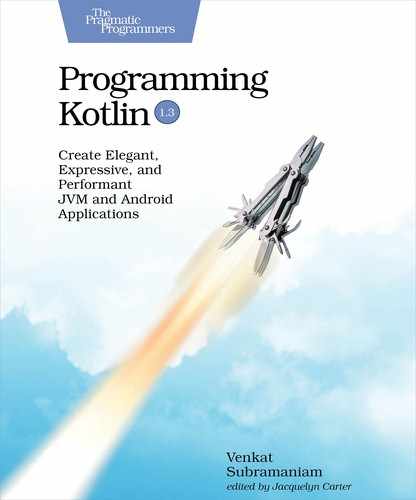Iterating over Arrays and Lists
You can seamlessly use any of the JDK collection classes and interfaces in Kotlin. Thus, you can use Java’s array and java.util.List in Kotlin as well. Creating instances of these in Kotlin is simpler than in Java, and you can iterate over the values in these collections with greater ease in Kotlin.
Let’s first create an array of numbers and examine its type:
| | val array = arrayOf(1, 2, 3) |
| | |
| | println(array.javaClass) //class [Ljava.lang.Integer; |
To create an array of values, use the arrayOf() function that belongs to the kotlin package. The functions that belong to the kotlin package may be called without the kotlin prefix—kotlin.arrayOf(), for example—or without any explicit imports.
Since all the values given are of type Int, the array created in this example is an array of Integer values. To create a primitive int array, instead of an array of Integer objects, use the intArrayOf() function. Irrespective of which function we pick, we can iterate over the array of values using the for(x in ...) syntax like before.
| | for (e in array) { print("$e, ") } //1, 2, 3, |
Likewise, you can create an instance of List<T> using the listOf() function and then iterate over its values using for:
| | val list = listOf(1, 2, 3) |
| | |
| | println(list.javaClass) //class java.util.Arrays$ArrayList |
| | |
| | for (e in list) { print("$e, ") } //1, 2, 3, |
Just like in the iterations we saw earlier, the variable e—for element of the collection—is immutable, leading to safe iteration.
The preceding iteration using for provided the values in the collection. But sometimes we need the index in addition to the value. The traditional for loop in C-like languages gives us the index, but not the value so easily. In this iteration we got the values easily, but getting the index, well, that shouldn’t be hard either. The indices property provides a range of index values. Let’s use that to iterate over a list of String values.
| | val names = listOf("Tom", "Jerry", "Spike") |
| | |
| | for (index in names.indices) { |
| | println("Position of ${names.get(index)} is $index") |
| | } |
Once we get the index value from the indices property we can obtain the value from the list at that position.
| | Position of Tom is 0 |
| | Position of Jerry is 1 |
| | Position of Spike is 2 |
Alternatively, we can get both the index and the position in one shot, using the withIndex() function along with an application of destructuring, which we saw in Destructuring, like so:
| | for ((index, name) in names.withIndex()) { |
| | println("Position of $name is $index") |
| | } |
You’ve seen how you can use the Java collections in Kotlin and also iterate over the values with greater ease. Later in the book we’ll see how to achieve greater fluency using internal iterators, when we discuss the functional style of programming.
When iterating over a collection of values, we often want to process the values, sometimes differently, depending on the value or its type. The handy argument-matching syntax will remove so much boilerplate code, as we’ll see next.
